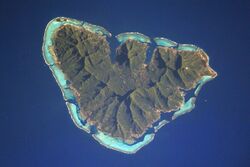High island
Topic: Earth
 From HandWiki - Reading time: 2 min
From HandWiki - Reading time: 2 min


Geologically, a high island or volcanic island is an island of volcanic origin. The term can be used to distinguish such islands from low islands, which are formed from sedimentation or the uplifting of coral reefs[1] (which have often formed on sunken volcanos).
Definition and origin
There are a number of "high islands" that rise no more than 1 metre (3 ft 3 in) above sea level, often classified as "islets or rocks", while some low islands, such as Banaba, Henderson Island, Makatea, Nauru, and Niue, as uplifted coral islands, rise over 50 metres (160 ft) above sea level.
The two types of islands are often found in proximity to each other, especially among the islands of the South Pacific Ocean, where low islands are found on the fringing reefs that surround most high islands. Volcanic islands normally arise above a hotspot.
Habitability
High islands above a certain size usually have fresh groundwater, while low islands often do not, so high islands are more likely to be habitable.
See also
- Earth:Archipelagic apron – Fan-shaped gently sloping region of sea floor found around oceanic islands
- Earth:Atoll – Ring-shaped coral reef
- Earth:Galápagos Islands – Archipelago and protected area of Ecuador in the Pacific Ocean
- Earth:Guyot – Isolated, flat-topped underwater volcano mountain
- Earth:Seamount – Mountain rising from the ocean seafloor that does not reach to the water's surface
- Earth:Submarine landslide – Landslides that transport sediment across the continental shelf and into the deep ocean
- Earth:Volcanic arc – Chain of volcanoes formed above a subducting plate
References
- ↑ Murphy, Raymond E. (July 1949). ""High" and "Low" Islands in the Eastern Carolines". Geographical Review (American Geographical Society) 39 (3): 425–439. doi:10.2307/210643.
External links
- Micronesian culture: High island and low island cultures at Britannica.com. Retrieved 2011-09-22.
 KSF
KSF